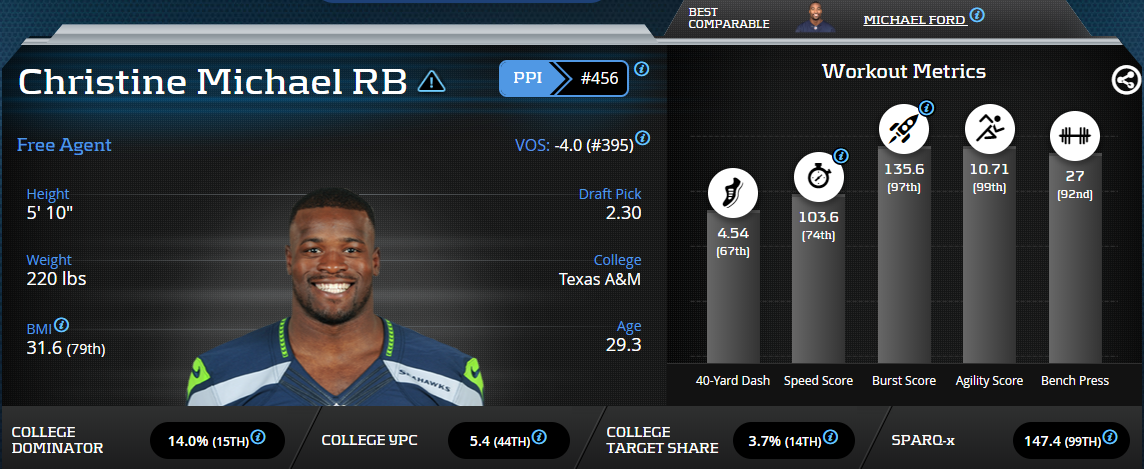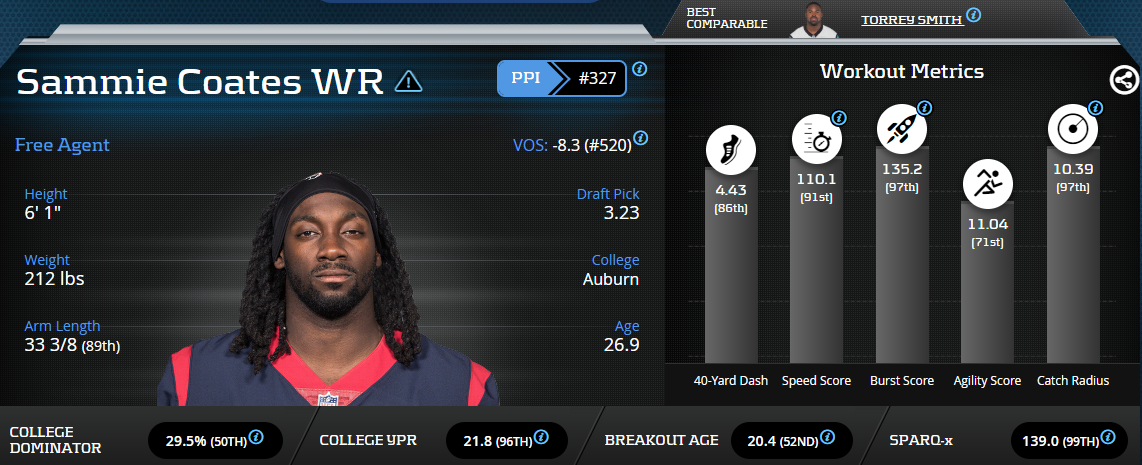The XFL is almost here and we’re barreling towards it like two grown men diving at football before the game even starts. Several coaches are expected to engineer electric and high-flying offenses. As of Wednesday evening, the Tampa Bay Vipers and Los Angeles Wildcats are the only teams to drop depth charts. Our knowledge of every other team is based on news reports, coach-speak, draft capital, advanced stats and metrics as well as other ancillary factors. This gives a major edge to those who have grinded the XFL news circuit for months.
Expect to recognize some names with many of these players being NFL backups and dynasty stashes at one point or another in recent years. In this first article, we’ll focus on the offenses as a whole and how they will fuel fantasy production. After this week, we’ll also provide a brief recap of the previous week before we get into the DFS action. Check in next week for a breakdown of the inaugural games, plus takes for Week 2. Let’s get into it.
Quarterback
There are three offenses deeply rooted in the history of passing-first attacks and one more that followed in their footsteps. Save for a few running backs, most of our fantasy players will come from these four teams:
- Dallas Renegades – Offensive Coordinator Hal Mumme is the founder of the Air Raid offense as we know it today.
- Houston Roughnecks – Head Coach June Jones founded the Run and Shoot offense which uses vertical route concepts to expose gaps in defenses, much like the Air Raid.
- Los Angeles Wildcats – Norm Chow was Offensive Coordinator at BYU in the 1980s, when LaVell Edwards was creating one of the first West Coast offenses.
- Tampa Bay Vipers – Marc Trestman was the Head Coach and Offensive Coordinator of the Bears and Ravens from 2013-2016. His teams passed at a top-five rate in two of those seasons.
L.A.’s Josh Johnson and Dallas’ Landry Jones are both dealing with injuries and should be considered game-time decisions. If either gets a clean bill of health, they’re the safest play of the week. The duo has the most NFL experience by far, with each having over 1,300 passing yards in the majors. For the price, look to Landry. He’ll be operating the most successful collegiate passing attack, one that he played in during his time at Oklahoma.
Phillip Walker was announced as Houston’s starter and has all the trappings of a tournament passer. His offense is based around creating mismatches and finding holes in defenses through vertical routes and quarterback rollouts. Walker rocks 4.79 (69th-percentile among qualified quarterbacks in the PlayerProfiler database) speed. Unlike Johnson, who ran a 4.55 (97th-percentile) over a decade ago, his speed hasn’t had time to fade away.
Running Backs
DraftKings and Fanduel both require us to start only one running back. If the AAF was any indication, bellcow backs will be few and far between. Trent Richardson was the only back with at least 12.5 carries and three targets per game. The only player who projects to dominate their backfield like Richardson did is former Seahawk, Colt, Cowboy and Packer: Christine Michael.
He’s a name people know and will likely be one of, if not the highest-owned rusher on the slate. St. Louis made Michael the first running back taken in the Skill Players Draft. They chose not to take another back until the seventh round. The Battlehawks also have the least appealing quarterback in Jordan Ta’amu. The Ole Miss product posted a 72.1 QBR while throwing to A.J. Brown, D.K. Metcalf and Dawson Knox. They’re likely to lean on the run unless Ta’amu impresses early.
Jhurell Pressley, who plays for the DC Defenders, is an athletic freak. He owns a 90th-percentile SPARQ-x score and marks above the 75-percentile in every metric but Burst Score. The New Mexico State product also had a 7.7-percent (55th-percentile) College Target Share and rushed for 7.8 (97th-percentile) yards per carry. His coach, Pep Hamiton, orchestrated notably run-heavy approaches at Stanford and at Michigan in addition to washing out of the NFL as the Offensive Coordinator for the Colts. Pressley is the perfect back to shoulder the load in a middling offense. Most importantly, he was selected by PlayerProfiler’s own Craig Wambold as the 54th pick of a 2016 mock dynasty rookie draft. Craig raved endlessly about Pressley’s monstrous potential, proclaiming in his breakdown that he was worth a flier.
Derrick Henry Lite?
The New York Guardians took Tim Cook in the fourth round after choosing three receivers (two of whom are on IR). Guardians coach Kevin Gilbride spent six seasons as the Offensive Coordinator for the New York Giants and his run/pass tendencies varied wildly depending on the talent he was working with. Cook may be in line for a massive workload if Gilbride moves away from the passing game. At 6-0, 242-pounds and sporting a 74th-percentile SPARQ-x score, Cook is the ideal back to handle that load and may end up being something of a poor man’s Derrick Henry.
Wide Receiver/Tight End
Both sites don’t require us to play a tight end because of how useless the position was in the AAF. They’ll be persona non grata in our lineups until further notice.
The top receiving options of the Big Three offenses are lineup cornerstones because of how easy it is to project them:
- Jeff Badet (Dallas Renegades) – 4.39 speed and played his final college season at Oklahoma.
- Sammie Coates (Houston Roughnecks)- 99th-percentile athlete with a 435-yard season in the NFL with Pittsburgh.
- Nelson Spruce (L.A. Wildcats) – 294 career receptions at Colorado, 21st all-time in the FBS.
The second receivers on Houston and Dallas will be particularly interesting stacking options for Week 1. Kahlil Lewis is set to lineup opposite Coates and already put on a show in Houston’s preseason scrimmage.
Nice TD catch and run by #Miramar HS (FL) alum, former #Cincinnati #Bearcats & #Houston #Roughnecks WR Kahlil Lewis (@K1_lewis) pic.twitter.com/zLkIXafhIL
— Sleeper Athletes (@SleeperAth1etes) January 22, 2020
Dallas’ Jazz Ferguson is currently dealing with a hand injury. That leaves the Renegades with five wideouts to handle the most pass-happy attack in the league. Expect the top options to see plenty of work and stay on the field for a majority of the game.
Flynn Nagel was a standout during January practices and should be the starting slot receiver in a Dallas offense that runs through the slot. If Ferguson can’t suit up, Nagel is in play for cash and frees up an immense amount of cap.
Long Shots
Freddie Martino spent three years in Tampa Bay and reeled in a handful of bombs from Jameis Winston. He broke out at the age of 19 and controlled over half of his college’s receiving production. Both of those are 90th-percentile-plus metrics.
Rashad Ross will be a popular play after he tore the AAF apart, earned a brief stay in Carolina and then was traded to DC after being selected by L.A. ninth overall. However, Ross will be faced with significantly more competition for targets this time around from former Steeler Eli Rogers. Malachi Dupree may also factor in as DeAndre Thompkins deals with an injury.
https://www.youtube.com/watch?v=ESsER4jtXO8
If Dupree gets a long ball and Ross has a quiet day as a result, he’d be an incredible leverage play. Many unnamed analysts had the LSU receiver as a top-five prospect at his position in 2017.
Defense
Don’t play a defense against one of the four pass-heavy offenses. Stick to home-favorites until that trend is proven wrong in the XFL. That leaves DC, New York and Dallas. Because we’re interested in the starting backs on DC and New York, those are the top two options of the week by virtue of the DEF/RB stack. The DC line is loaded with Power Five talent, including tackles from Ohio State and Washington. New York’s secondary has been praised as being among the league’s best heading into Week 1. Jamar Summers was considered the best AAF cornerback and Ranthony Texada was a standout at TCU.






